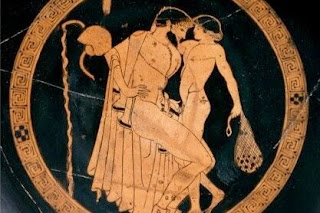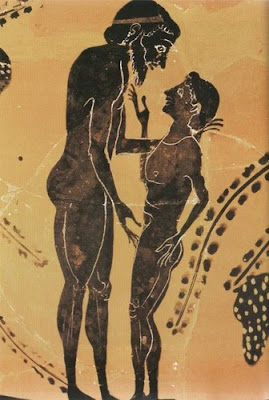Uncovering the Hidden Truth: Pederasty in Ancient Greek Civilization.
Uncovering the Hidden Truth: Pederasty in Ancient Greek Civilization.
Let’s dive into this delicate topic headfirst; what exactly was pederasty in ancient Greece? Pederasty in ancient Greece was the name given to a sexual relationship between an adult male and young boy, usually in his teens. But how was pederasty conducted, how common was it, and was it socially accepted?
 |
An Athenian red-figure cup depicting a seated adult male with a naked boy (c. 470 BC)
Pederasty literally means lust for, or love of, in a strong sexual sense, children. An illegal and totally unacceptable practice today; thus, the subject of pederasty is a highly sensitive one. In ancient Greece pederasty (paiderastia) refers specifically to boys. The relationship was between an adult male over the age of 20 (the erastes) and a younger male (the eromenos). The erastes might be what we would call “exclusively “homosexual, but they might be married to a woman as well – and that is, of course, not unknown in our society today.
Was pederasty considered to be socially acceptable in ancient Greece? It was extremely complicated, there were lots of shades of grey. Very rarely was pederasty criminalized, but there were rules and regulations, it was not a “free for all”. There were many, many different Greek societies, each with their own social and sexual norms and legal regulations. But there were some commonalities. There was a voting age for males, an age of majority, 18 at Athens for example, but there was no “age of consent” as we understand that legal concept today.
If it was thought that the junior partner was being forced into it, then that was not good, that was frowned upon. Predators who went around looking for young boys to get off with and to have sex with were frowned upon very strongly. And if you were a young man offering sexual services – in other words if you were, let’s say, 17, and you openly or covertly offered your body for purely sexual reasons to an adult male – well that could be subject to an accusation of criminal prostitution, which would have political consequences. The crucial point was the age of the younger, junior, subadult party, and how much agency that junior partner had.
 |
Young man and teenager engaging in intercrural sex, fragment of a black-figure Attic cup, 550 BC–525 BC, (Louvre Museum) |
For example; a 12-year-old boy was going to be less able to have a say in resisting or in manipulating or determining the nature of the relationship with the older man, than, say, a 17-year-old boy. At 17 you might well be the junior partner in a homosexual relationship with a man only a few years older than you – in other words, it might have been considered to be quite an equal relationship. However, even if you were 17, you weren’t a legally independent adult.
There were also rules forbidding sexual congress or sexual arrangements in the gymnasium. Lots of Greek cities had areas where you could exercise – ancient Greeks were very keen on athletics, especially wrestling, and they typically exercised nude. Which is why it’s called a gymnasium – “gymnós” means “naked”. There were various rules around gymnasiums – for example, slaves were barred from using them because it was thought it would be too easy for a free citizen, an adult male, to do what he wanted to them. And if you were over the age of 40 you were not allowed to be in a gymnasium with young boys present
Now, let’s move on to the risqué topic of how common pederasty was in ancient Greece.
It is difficult to generalize about the frequency of pederasty in the ancient Geek world. The evidence suggests that, although it was really quite widespread and in that sense “normal”, on the other hand different Greek societies operated with different kinds of social tolerances. In Athens, for example, where elaborate courtship rituals and protocols were in place, it was probably a practice mostly confined to the socially elite, the wealthier classes. In other cities – especially Sparta, on the other hand, it was a rite of passage for all males, it was part of transitioning from adolescence to full civic adulthood.
In Sparta, it seems that pederasty was not optional at all; in other words, as part of the educational cycle in Sparta you were paired up with an adult Spartan warrior for mutual benefit. The older partner would instruct the younger, would be their mentor, while the junior partner provided sexual satisfaction and companionship in a society where, before you were married, it was actually very difficult to have any relation with the opposite sex.
 |
Man and adolescent male, c500 BC.
Did pederasty extend to young girls as well Unlike Athenian girls, for whom there were no formal educational establishments, Spartan girls did have some form of public education, which involved athleticism as well as learning to read and write. There is one passage in a very late source about Sparta which says that before they were married, very high-ranking Spartan women might select suitable girls, i.e. aged 15 or 16, as a female partner. Similar to Spartan boys, for whom it was considered educational to be in a relationship with an older adult male.
But historians tend to think this notion is slightly dubious. Nowhere else in the Greek world is there mention of it. Well-known exception is Sappho (Archaic Greek poet from the island of Lesbos known for her lyric poetry); Sappho and her female students or friends both composed and sang verses together. There, on the island of Lesbos, in what was a much earlier time period, around 600 BCE, Sappho and her female companions – who were perhaps also lovers – traded passionately erotic verses.
 |
Plato and Aristotle.
Last but not least, what did great Plato think about homosexuality in the form of pederasty? There’s a famous – or rather, notorious – passage in Plato’s The Laws in which he asks how we should regulate sexual relations. And regarding to the question of “are same-sex relations between men, OK?” Plato says: “Well, no! Because they are unnatural, against nature, in that they don’t give rise to offspring.” Plato, in a way, was closer to the Christian view of the purpose of marriage being to produce legitimate offspring, to have sex only within marriage.
But, interestingly, in an earlier work, entitled Symposium, in which the topic of discourse was erotic love, Plato, through his mouthpiece Socrates, celebrated same-sex relationships between men for supposedly elevating the behavior of both men. Plato said same-sex relationships between men were a sort of “higher form” of converse than purely physical (unlike male-female relationships, because women were not typically educated to be equals with men in ancient Greece). For whatever reason, Plato made a sharp turn from celebrating a form of idealized, spiritualized homosexuality to a position of being very negative and down on it.
By the way, Plato never married, which was very unusual for his time. We will never know whether or not he was exclusively homosexual, but by the end he was pretty sour and embittered and quite critical of any sort of what he considered “deviant” behavior. Ironically, he offered fierce punishments for such behavior in his theory of the ideal state, which was not very “ideal” by most of our standards today.










Comments
Post a Comment